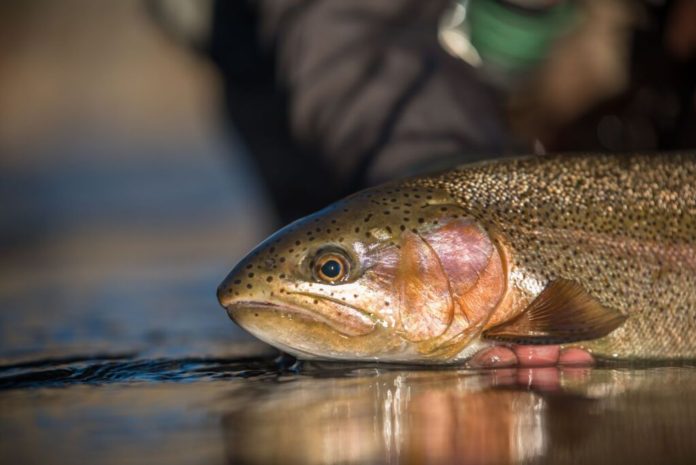Special to the Daily
A major benefit of living in the Colorado Rockies is a close proximity to a variety of water types. Lakes and reservoirs, tailwaters, small streams and big rivers all hold high levels of teeny nymphs that trout feed on all year long. The majority of small bugs are midges, however most insects start off small. The amount of time insects spend during development in the larvae and pupae stages increases the success anglers experience when nymphing with tiny flies. But how small is too small?
For most anglers, it is hard to look out over a broad river hoping to tempt a trout to eat and the first fly you select is a size 18 nymph. It is a common misconception that it takes big food to catch big fish. A more common truth is that big water holds trout that eat tiny bugs. That factor becomes ever more apparent on pressured waters.
During insect development, nymphs naturally spend a longer amount of their lifetime in the larvae and pupae stages, the smallest stages of the insects life. And insects spend an extended amount of time in those developing stages in cold, winter temperatures. The prevalence of midges, the most prolific food source in any water, lasts all year long making midges the food source trout feel most comfortable eating.
Educated trout quickly learn that small foods are safe foods even during the warm weather months when larger bugs are more prevalent. Trout accustomed to seeing anglers regularly become wary of larger flies.
Special to the Daily
Small nymph flies, size 18-22, have a crossover appeal where a small mayfly nymph will be eaten during a midge hatch. Rarely do anglers need to tie on smaller nymphs on our local waters, Gore Creek, Eagle River and Colorado River. However, some of the nearby tailwaters like the Fryingpan River and Blue River with their highly educated catch and release trout necessitate something smaller.
Trout forced to eat small bugs in the winter or from pressure need to eat exponentially more times to maintain survival. More eats equals more chances for anglers to achieve success. An analogy I like to use is that a person eating one peanut at a time is going to survive but that person needs to eat a lot of peanuts in a row to do it. The same applies to trout feeding on midges or tiny emergers.
Small flies have unique character traits that require an appropriate tippet to fly relationship. Tiny nymphs require thin tippets for success. That means 5X or smaller. However, I have never experienced the necessity to go smaller than 7X.
Benefits of thin tippet would be increased invisibility — the small diameter line is harder to detect. Nymphs drift with a free flowing movement selling the illusion of disconnection. Thin diameter tippet sinks more quickly.
Weaknesses of thin tippet would be breakage from improperly set drags, and knots are harder to tie. Small diameter tippets require the use of micro shot to prevent damaging fragile lines that large weights can do. Fish fighting requires more finesse and soft tips to prevent breakage.
Special to the Daily
Anglers need to work slowly when fishing with small nymphs. Picking apart a section of river with precise nymphing techniques will yield success. The well known saying, foam is home, resonates when fishing with tiny flies. Foam lines illustrate appropriate feeding lanes for nymph fishing.
Teaming up a tiny nymph with another larger offering is a common approach. Jeff Lyon, past head instructor of Orvis Fly Fishing School at Cordillera and current Vail Valley Anglers guide, fishes a wooly bugger by dead drifting and trails the bugger with a tiny nymph. Referred to as a “Happy Meal,” this rigging produces reliable results. However, highly pressured waters are best fished with a tandem of tiny nymphs. It is better to fish with two bugs the trout will eat rather than using one purely as an attractor.
As the most prevalent food source in any water type, midges and other small nymphs account for more “eats” than any other insect. Anglers looking to gain admission into the “20 on 20 Club” will need to land a trout over 20 inches on a fly size 20 or smaller. Tiny nymphs paired up with the appropriate tippet and fought with finesse are the keys to fly anglers gaining membership. So when the question arises, how small is too small? Just small enough to get a trout to eat.
Michael Salomone moved to the Eagle River valley in 1992. He began guiding fly-fishing professionally in 2002. His freelance writing has been published in numerous magazines and websites including; Southwest Fly Fishing, Fly Rod & Reel, Eastern Fly Fishing, On the Fly mag, FlyLords, the Pointing Dog Journal, Upland Almanac, the Echo website, Vail Valley Anglers and more. He lives on the bank of the Eagle River with his wife, Lori; two daughters, Emily and Ella; and a brace of yellow labrador retrievers.
Credit: Source link






























